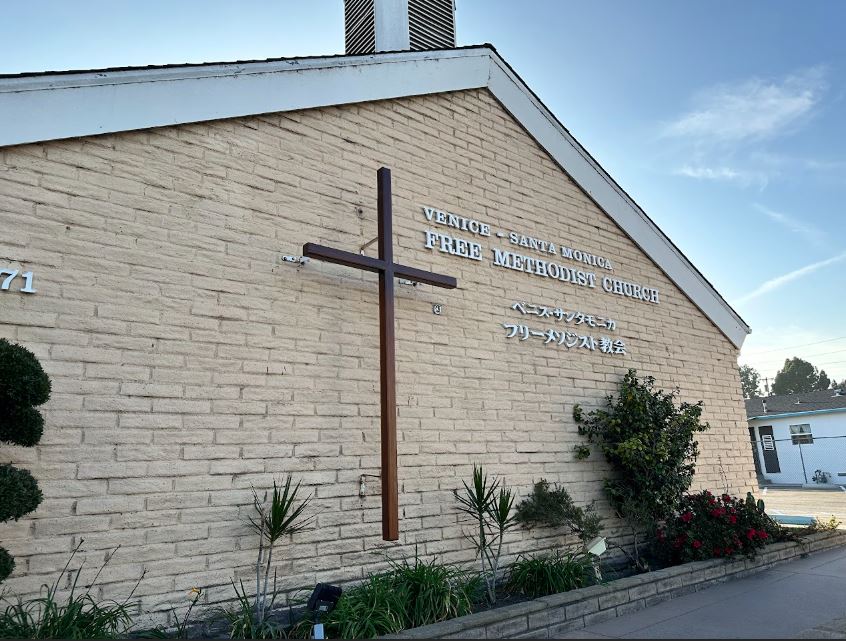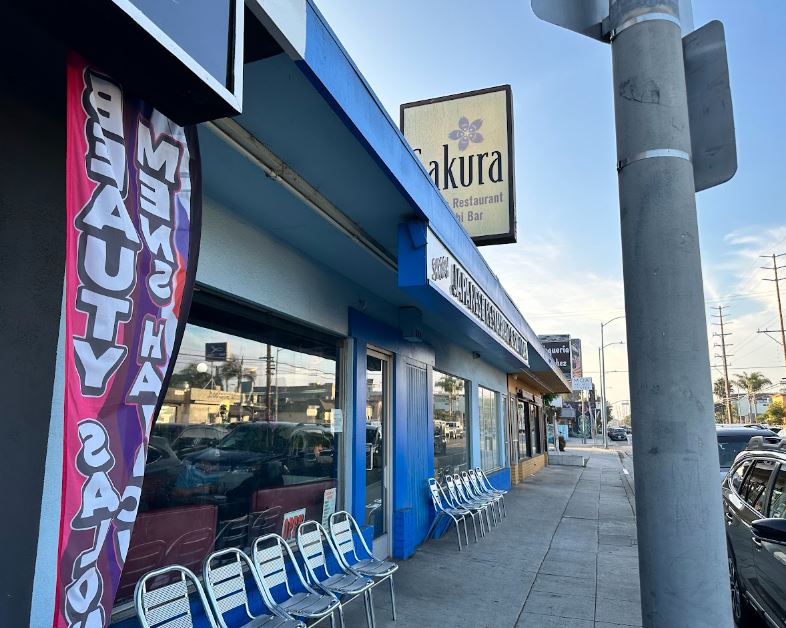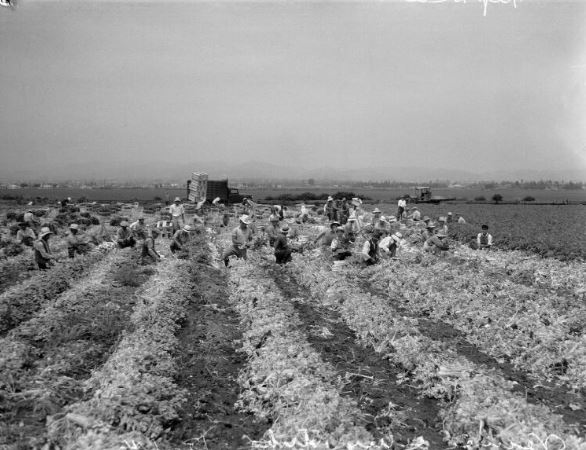By Aviraj Gokool
(This is part of our ongoing series, Lost Kinjo– a look at the more than 40 Japanese communities that disappeared after World War II. It is supported by funding from the California Public Library Civil Liberties Project and the Takahashi Family Foundation.)
Every July in Venice, California’s cute canals, colorful beachside stores, and glamorous bodegas echo with the banging of taiko drums and unison shouts heard down Braddock Drive.
Follow the source of these nostalgic Japanese summer sounds and you’ll end up at a large beautiful Japanese temple with sleek black eaves, dark oak wood pillars, and pristine white walls. The Venice Hongwanji Buddhist Temple immerses you with its architecture making you feel like you’ve stumbled upon a traditional temple in the middle of Tokyo’s skyscrapers.
After a short speech, the banging of the drum signals the start. In unison, waves of people begin the bon odori.
For several decades, the temple has celebrated the Obon Festival where people honor family members who have passed away and hold them in memory. Every year, more people gather for this event as it’s a big event for the Japanese American community to gather and socialize with each other.
It’s also become a place where those outside the community can learn more about and celebrate traditional Japanese festivals, indulge in authentic Japanese food, and support a deep-rooted group with a long history in Venice. But no matter their background, people always give remembrance, gratitude, and blessings to the Issei (Japanese immigrants) that first settled in Venice in the early 1900s.
Farming as a way of life
Arriving from farming prefectures like Kochi-ken or Shiga-ken, Issei immediately fell in love with Venice’s rich and bountiful farmland. Venice’s Japanese population numbered less than 100 in the 1920s as it wasn’t as popular a destination as neighboring cities like Santa Monica, Terminal Island, or Sawtelle, but there was still a small active community.
“In that area, including west LA, there were many village friends farming from my parents’ village,” Arnold Maeda, a Nisei who grew up on his father’s farm in Venice, said in a Densho interview
Still, unless they purchased their land early on, it was hard for Issei to establish their own farms due to the Alien Land Laws. As such, many leased the land, became truck farmers, or worked on other people’s farms. These old discriminatory laws didn’t stop Japanese settlers from profiting off of Venice’s lush farmland.
Venice was the prime growing grounds for celery, America’s cash crop during the 30s and 40s. Every farmer in the Venice area harvested celery in vast amounts. The local Issei even established a Celery Farmers Association on Jefferson Blvd. But Japanese farmers would raise other vegetables like string beans or cabbage during the off seasons.
“It was like a guessing game for the farmers because if they picked the right item that there’s a scarcity of at the time, then they would get good money and they would hit the jackpot. But if everybody happened to grow the same thing, the market got flooded with it and prices dropped, and so it would become a bad year” Noboru Kobayashi, who grew up in Venice, said to Densho.
It wasn’t until the 1930s, when Issei settled down, got married, and had children, where LA’s Japanese population essentially doubled. This number was reflected in the city of Venice as well.

A growing Japanese American community emerges
A grocery store, general store, and barber catering to the Japanese community gradually emerged. A Japanese language school was constructed on Braddock Ave. for young Nisei (second generation American-born Japanese) while a Japanese Association Office targeted older adults. Most of all, about eight nurseries were eventually established in Venice’s localized Japantown.
“I envied the American kids that went to school, and at three o’clock, they just went home and played, whatever they wanted to do,” Kobayashi said reflecting on attending Japanese language school. “But yet, we were kind of in a position where our hands were tied, and it was a routine that you don’t ditch school because, if you do, your parents would find out immediately, and that was a no-no.”
Additionally, just outside the main area of Venice along the pier, there was a small enclave of Issei and Nisei, like Esther Takei Nishio’s family, running carnival booths and operating rides at the Venice Pier.
It can be assumed that given the proximity to larger Japanese hubs in Sawtelle, Little Tokyo, and Santa Monica, Venice’s Issei and Nisei community frequented these neighboring Japantowns for restaurants, cultural centers, and more.
Incarceration and mass hysteria disrupts life
However, once Order 9066 was enacted, Venice’s small cultural hubs and the ones surrounding it quickly disappeared.
Coastal cities were targeted first. On Dec. 7, 1941, over 1,200 Issei fishermen, buddhist priests, and community leaders were detained, arrested, and sent to prison on suspicion of being spies and working for Japan.
Some shops were raided. Issei and Nisei were forced to sell their establishments at cut rates to greedy businessmen taking advantage of the situation. Those who weren’t immediately sent to prison were given short notice to gather their belongings and prepare for mass incarceration.
“I remember people coming to buy furniture,” Maeda said while talking about the loss of his parents’ nursery. “I remember especially one man who flipped a coin and said something like,’”Heads, I’ll pay you fifty cents. Tail, I get it for free.’
Families tossed, buried, or cached anything related to Japan or their hometowns. Traditional kitchenware, toys, and books were destroyed.
“My mother and brother were busy taking our photo albums, and in the backyard, built a bonfire and were burning up all the photographs,” Kobayashi said. “Because the thinking was that if they see these photographs, it’s going to incriminate him, so they were getting rid of evidence, you might say. But I don’t think that would have made any difference, now that the time has passed.”
Families fit what they could in one or two large suitcases and boxes. Then, on April 25, 1942, Issei and Nisei families in Venice lined up on the corner of Lincoln Boulevard and Venice. Among the crowd were a young Maeda yearning for his dog and Kobayashi who was blissfully unaware of their destination: Manzanar.
“We had a few suitcases and boxes and so forth, that we packed up and we took it to the Venice Japanese School, and they had a building that they put up in 1941, ’40 or ’41, and all the Venice local people took whatever they wanted to maintain over to that area, and they made a storage building,” Kobayashi recalled.
Families, children, and adults who were chasing the American dream were stuck in a three year purgatory hell. Families were crammed in uninsulated military barracks where people used makeshift partitions and curtains to create separate spaces.
Inmates were served undercooked rice and eggs as well as dubious meats. Sugar and other foodstuff products were in constant shortages. The only saving grace was how skilled Issei farmers were able to cultivate the land and grow higher quality produce.
Unrest and weary piled up in the prison camp. From broken promises, animosity and rage against the War Relocation Authority, and rumors of kitchen supplies being stolen and sold in the black market, a riot ensued. The riot took two lives; 17-year-old James Ito passed away from a gunshot and 21-year-old Jim Kanagawa of Tacoma, died of injuries several days later. Nine others were shot but ultimately survived.
Alongside inhumanely imprisoning thousands of innocent people, these camps served as a way to instill fear into the Issei and Nisei communities. It was a way to shame them for celebrating their cultures, expressing their identities, and preserving their heritage. But the community found workarounds.
Inmates established Japanese schools to continue teaching the language and culture. Among the many physical recreations like baseball or football, traditional Japanese sporting activities like judo was a popular way to pass the time.
With the ingenuity from farmers and chefs, traditional foods like shoyu, bean sprouts, tofu, miso, tsukemono (Japanese style pickled vegetables) were eventually served in the mess halls.
In addition with the Christian Church, a Buddhist Church that celebrated Japanese festivals like Obon kept the Japanese spirit during the incarceration period quite strong.
Returning to Venice proved difficult
In this fashion, the Issei and Nisei prevailed until the end of their incarceration period in the spring of 1944. Some, like Kobayashi’s family, chose to go back to Japan while others moved to the east coast where job opportunities were prevalent and discrimination was low. Those who moved back to their former neighborhoods, like Maeda and Takei Nishio, mostly became gardeners, tried to restart their businesses, or were lucky enough to have friends that looked after their properties.
Others were not so fortunate. For those that lost their property and belongings, they had to live in temporary housing, dilapidated apartments, and needed several jobs to support themselves and families. But no matter the situation, the community always helped each other.
Those that migrated back to Venice were fortunate to have temporary but ample housing at their community center on Braddock, a building bought out by a group of Issei just before the mass incarceration. Lines of tents were also set up along the sidewalk of the building and the Venice Issei and Nisei shared stories over hot meals and kept each other company. Inadvertently, a small tent community was established.
“In 1941 or ’42, [Issei] purchased the property right there on Braddock, and that’s where they kind of consolidated the judo and the Japanese school, and that’s where they continued on.” Kobayashi said.

Additionally, Reverend Clyde Barnett of the Santa Monica Free Methodist Church was another major factor in why people returned to Venice. During the incarceration period, Reverend Barnett maintained the vacant Japanese Community Center until people returned. He also opened the building as a temporary accommodation center and assisted families until they could support themselves.
“I heard that until they found a place to settle, families with children slept in the center’s classrooms, and single people lived in tents on the grounds,” Perry Miyake, sansei (third-generation Japanese) author, said in a Discover Nikkei article.
People eventually made a living mostly as celery farmers and gardeners. The community often gathered at the community center in Braddock or frequented the Free Methodist Church. As the Issei and Nisei regained their footing, people gradually moved out of the area due to either job relocation, school opportunities, or Venice’s ever increasing housing prices.
“Many of the people returned to the area, but that gradually changed as the kids grew up and they moved to, further out to where more homes were available,” Kobayashi said. “And so there were a number of people throughout the area that returned to the close vicinity of where they left.”

There were a few Japanese stores down S. Centinela Ave., a few blocks away from the community center, but eventually almost every store closed down. Only two stores remained: M&S Pharmacy and Sakura Restaurant. However, at the end of Sept. 2024, M&S Pharmacy had to permanently close their doors after operating since 1953. Sakura Restaurant, bustling with a multitude of local Venice customers, is the only remainder of the Japanese postwar businesses.

A legacy remembered
However, the legacy of the Venice Issei and Nisei still live to this day.
On the northwest corner of Venice and Lincoln Boulevards, a 9′ 6″ tall solid black granite obelisk glistens under the sun, grabbing the attention of anyone that passes by. On the street facing side, a description of Order 9066 and details of the forced removal is written with a picture of Issei and Nisei preparing to board the bus to Manzanar. “VENICE JAPANESE AMERICAN MEMORIAL MONUMENT” is written underneath it all.
The construction of the Venice Japanese American Memorial Monument was spearheaded by retired Venice High School teacher Phyllis Hayashibara but was constructed, supported, and realized by former Manzanar internees, Friends of Manzanar, the Venice Arts Council, the Manzanar Committee, and more. It serves as a reminder of the incarceration and immortalizes the experiences prisoners like Maeda went through. The monument is regularly maintained by Hayashibara, the Venice community, and local businesses and is a beacon of hope and perseverance.
The Venice Free Methodist Church remains very active and vibrant in the community as they hold regular events and Japanese language services for church goers.

Current generations of Japanese Americans still gather at the Venice Japanese Community Center on Braddock Dr., the same original building that was bought out by the Issei in the 1940s. The center preserves Japanese American history and also thrives with community events, cultural arts, taiko, basketball, and more than 30 clubs.
Lastly, the Venice Hongwanji Buddhist Temple is a site that many locals and travelers visit to this day. It has several organizations, regular morning services, and hosts the famed Obon festival. All three locations work closely with each other and the Japanese community.
Though many families may have dispersed and are not as close in proximity as they were during the prewar era, the current community still gather at centers long established by former generations of Issei and Nisei.
Most of the Issei and Nisei community may be gone but their hardships, bravery, and memories will forever be remembered and carried on by future generations.
AsAmNews is published by the non-profit, Asian American Media Inc.
We are supported through donations and such charitable organizations as the Robert Wood Johnson Foundation. Donations to Asian American Media Inc and AsAmNews are tax-deductible. It’s never too late to give.
Please also follow us on Instagram, TikTok, Facebook, YouTube and X.



I just wanted to pass along one correction: Phyllis Hayashibara’s first name is misspelled in the article (it should be Phyllis and not Phylis). But thank you for such a wonderful and thorough examination of the history of the Japanese American community in Venice.
Thank you. The spelling has been corrected.
Thank you so very much, Aviraj GoKool, for your well-researched article on the Japanese Americans in Venice, California, before and after World War II. I am especially grateful for your including the Venice Japanese American Memorial Monument! I just received the link to your article, and am eager to share it with the members of the VJAMM Committee, members of the Venice Hongwanji Buddhist Temple, and of the Venice Japanese Community Center. In appreciation, Phyllis Hayashibara